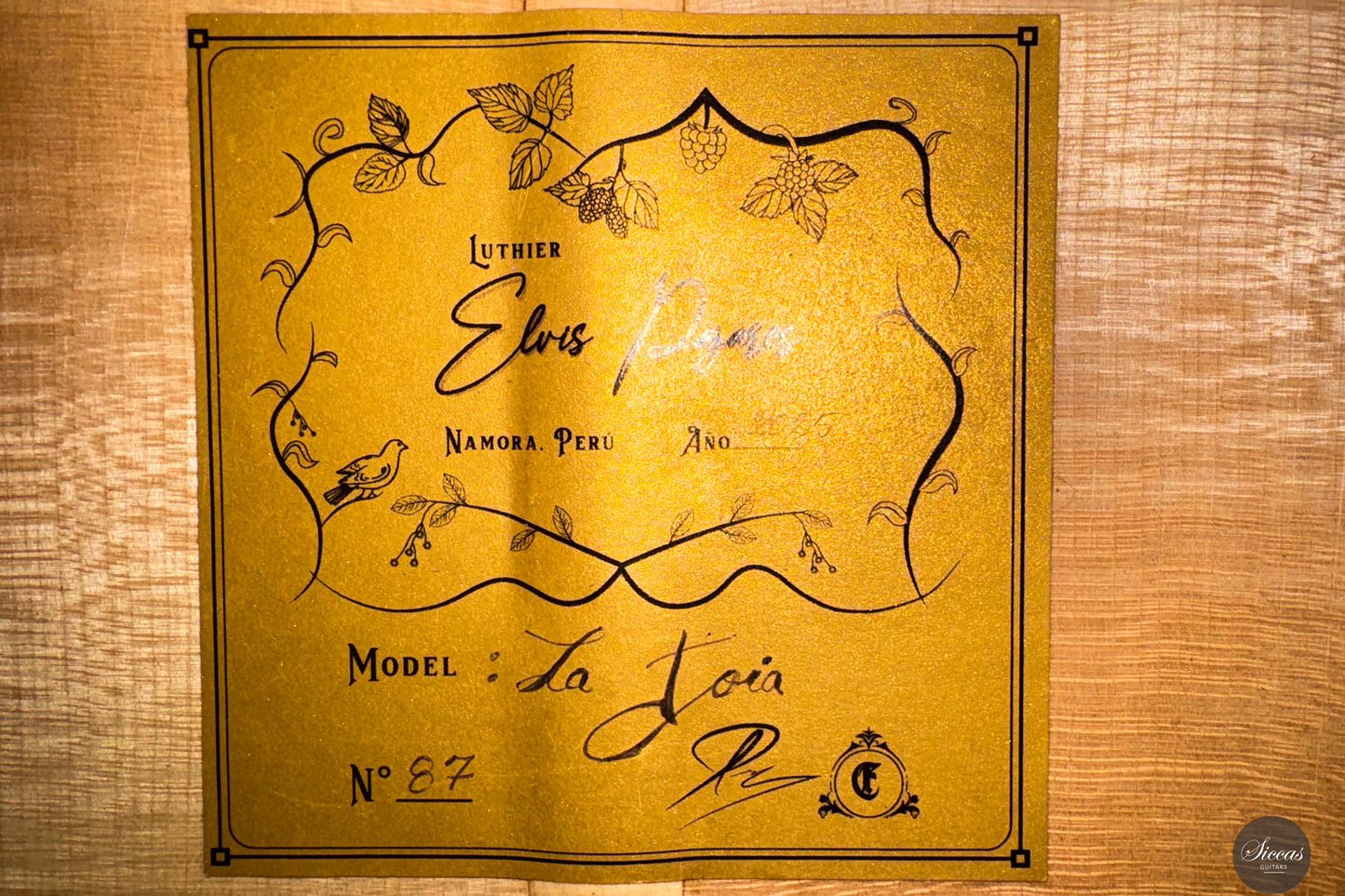Elvis Pajares - 2025 - Traditional No. 87 "La Joia" Spruce
Elvis Pajares - 2025 - Traditional No. 87 "La Joia" Spruce
Details
Details
Overview
Overview
Shipping important note
Shipping important note
Delivery times are typically reliable and most instruments arrive within the estimated timeframe.
Should any unexpected delay occur, our team will keep you informed and provide support at every step. For all shipping details and exceptions, please see our Shipping Policy.
Details about GPSR
Details about GPSR

























Video overview


More details about the guitar
About the luthier
Elvis Pajares is a talented luthier from Namora, Peru, who continues a long family tradition of guitar making. Deeply inspired by the great Spanish masters, Antonio de Torres, Francisco Simplicio, and José Luis Romanillos, as well as by the innovations of modern double-top designs, Pajares combines classical heritage with a contemporary vision of sound and structure. Guided by his intuition and curiosity, he has achieved remarkable results by exploring both traditional and modern concepts of the guitar. For the past three years, he has collaborated closely with guitarist and teacher Rodrigo Herrera, whose experience as a pedagogue and concert performer has played a fundamental role in the design of his most recent instruments.About the guitar
“La Joia”, numbered 87, is a traditional concert guitar built in 2025 and named after the Catalan and Old Spanish word for Jewel. It pays tribute to the golden era of Spanish guitar making and draws particular inspiration from Antonio de Torres. The internal structure is based on Torres’ 1888 guitar “La Italica” (SE 116), with an additionala transverse harmonic bar in the style of Robert Bouchet, and complemented by a modern 12-hole tie block for improved string angle and response. This guitar is designed to achieve an ideal balance between structural lightness and tonal depth. Every material has been carefully selected and calibrated to produce a sound that is both radiant and rich. The spruce soundboard contributes warmth and precision, while the flamed maple back and sides are chosen for their clarity and powerful projection. The traditional seven-fan bracing supports a resonant, well-sustained tone that blends lyrical singing qualities with articulate response across all registers. “La Joia” stands as a refined homage to Torres’ legacy, filtered through Pajares’ craftsmanship and deep understanding of the Spanish tradition.Regular care extends the life of the instrument
Even with careful use, a classical guitar may gradually change in appearance or respond to unstable storage conditions. Have a close look at your guitar regularly and be attentif to changes. If your instrument is suffering from its environement, it will let you know.
Protect Your Guitar: Handle with Care
Be mindful when touching your instrument with greasy or unwashed hands: any skin contact is a small attack on the varnish. Of course, a guitar is made to be played, but taking a few precautions helps preserve its beauty: wash your hands before playing, wear long sleeves, and avoid unnecessary direct skin contact with the body of the instrument.
Pro tip: Avoid playing with a button-up shirt, heavy jewelry, or a belt, as these can scratch the guitar. Also, make sure your guitar case is free of any objects that could damage the instrument during storage.
String care
A good habit to adopt is wiping down your strings briefly after each playing session. This small action significantly extends their lifespan and helps maintain a consistent, comfortable feel under your fingers.
Most importantly, clean strings are essential for keeping your instrument in tune. Corrosion, sweat, and dust can affect the uniformity of the strings and interfere with accurate tuning across the entire fingerboard.
Pro tip: If you're having trouble getting your guitar in tune, it might be time to change the strings. A useful test is to compare the pitch of the 12th fret harmonic with the fretted note at the 12th fret; if there's an unusually large gap between them, your strings may have lost their integrity and should be replaced.
Keep Your Shellac Finish Shining!
Got a guitar with a shellac (French polish) finish? Here's a simple trick: Take a clean microfiber cloth and gently breathe on the surface to create a light mist. Then, softly rub to remove fingerprints, sweat, and grease. That’s usually all it takes to keep it looking great, no products needed!
Pro tip: Every few years, treat your guitar to a check-up with a luthier to keep it in top shape.
Storing Your Guitar: Climate Matters
Your guitar can safely stay outside its case, as long as the surrounding environment maintains 42–55% humidity and a temperature between 18–25°C.
Keep in mind that humidity levels can still fluctuate inside the case, especially during seasonal changes.
- Too much humidity may cause overtightened strings and a dull tone.
- Too little humidity can lead to a bulging top, string buzz, or even cracks.
Avoid placing your guitar near radiators, air conditioners, or windows with direct sunlight.
Pro tip: Always close your guitar case while playing. This helps preserve a stable microclimate inside the case, so your instrument is protected the moment you put it back in.





















































